The main diseases and pests of Paulownia
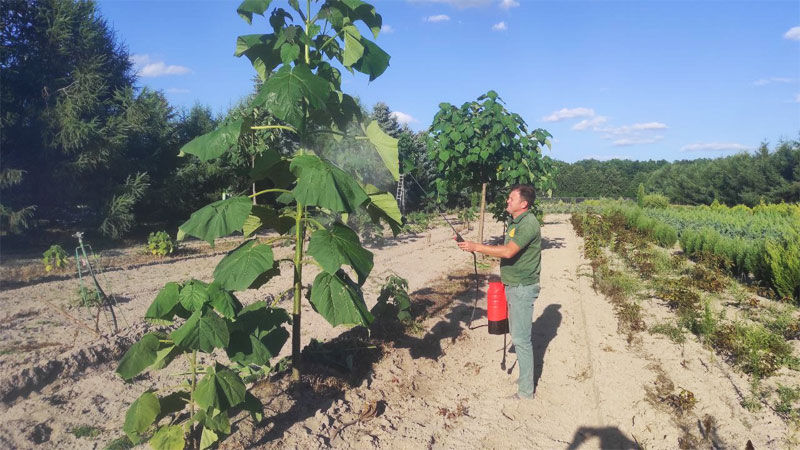
Treatment of Paulownia against parasites.
Paulownia is affected by many diseases and pests. In the north, it is mainly infested by witches' broom, although attacks by leaf-eating insects are also a serious problem. In the south, it is mainly infested by leaf-eating insects and weevils. In addition, scab beetles and woodpeckers are also common.
-
Witches' broom disease.
Witches' broom paulownia is a serious disease today (Figure 1-2). It is most severe in northern regions. In recent years, it has been observed that witches' broom has spread southward. It impairs the growth of trees and kills young shoots and saplings. The spread of witches' broom is facilitated by the increase in the area planted with paulownia and the large amount of material used for vegetative propagation.
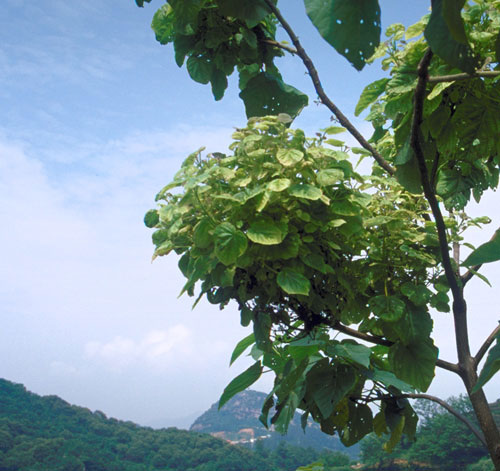
Photo. 1.

Photo 2.
-
Symptoms
Witches' broom is an infectious disease. Symptoms appear on branches, trunks, flowers and roots. The main symptoms are listed below, but they vary with the species. On infested branches, axillary and adventitious buds sprout in large numbers and form clumps of twigs. Internodes are thickened and phyllotaxis is altered. The leaf blades are yellow, small and thin, with distinct veins and wrinkles. These twigs do not drop in winter and look like brooms, hence the name of the disease. They eventually wither and die a year or two after being infested. The petals become leaves and the pedicels turn into twigs on which axillary buds develop and new clusters of twigs form. The calyx becomes thin, pale yellow, transparent and glabrous. The peduncle is completely deformed.
Trees of different ages can be affected by this disease. In areas where witch hazel is a serious disease, the incidence in seedlings is about 5%. In young trees, it is 5-30%. Recovered seedlings are severely affected. The cumulative incidence is 50-80% on paulownias older than 4-5 years. Paulownia witches' broom seriously affects the growth of young trees and reduces tree growth by 20-25%. It also seriously affects the growth of the root system. In 1975, research was conducted on nursery plants, primarily on the root systems of completely diseased plants, plants with diseased roots, and healthy plants less than 1 m tall. Results showed that the total root system length of healthy seedlings was 1230 cm, compared to 465 cm for infested seedlings.
The introduction of the witches' broom pathogen into trees causes a number of physiological changes that result in metabolic changes, metabolic disturbances, imbalance of energy metabolism, malnutrition, and progressive death. Tests show that the chlorophyll and protein content of infested leaves decreased by 30-40% compared to healthy leaves.
-
Pathogen and infection
Infected materials were examined by light and electron microscopy. Ultrathin sections of leaf stems and leaf lamina tissue, and mycoplasmas were detected and examined by electron microscopy. Numerous mycoplasmas exist in the sieve tubes of affected trees, with large and small particles mixed in the same large and small sieve tube. Mycoplasmas vary in shape (round, ellipsoidal, etc.) and size (200-820 m in diameter).
The disease is usually spread by the use of infected plant material and by certain insects such as Empoasca flavescens. Seeds from diseased trees are free of the disease and normal seedlings and saplings are formed when they germinate. Inoculation of the pathogen by mechanical means is also possible.
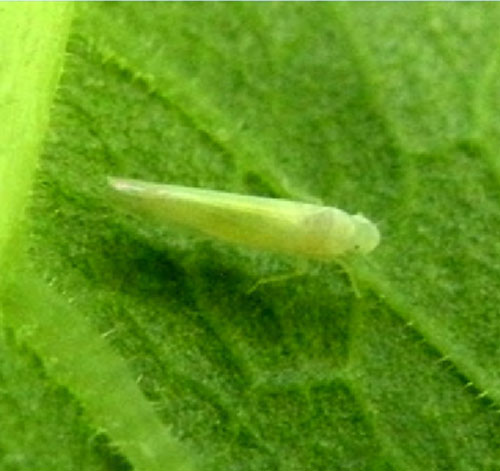
Photo 3.
-
Control methods
The following control methods are used.
- Affected trees should be removed from the nursery, as well as from newly planted areas, as soon as they are found, and burned.
- Affected branches are cut from trees, preferably three years old and older, and coated with a terramycin and petroleum jelly ointment (1:9) applied to the wounds, which should be wrapped and covered with a polyethylene cloth. After three years, a comparison of trees pruned with and without the use of the ointment showed improvement. However, it is preferable to apply the ointment because it promotes wound healing, reduces subsequent infections, and keeps the pathogen within the trees. Comparative data on the effects of pruning at different seasons showed that pruning twice, in summer (usually mid-June) and early fall (first half of September), produced better results, because summer and early fall are active periods of tree growth, during which the pathogen moves with the main flow of nutrients and shows symptoms of infection. Pruning in summer and early fall can therefore reduce the incidence of the pathogen. The frequency of pruning depends on the state of the disease.
- Disinfection of affected roots: The roots of plants affected by witches' broom have become a major cause of the spread of the disease in recent years. Growing seedlings from treated roots can prevent or reduce the infestation. There are several treatment options:
- Soak the roots in hot water at 45-48°C for 20 minutes.
- Soaking the roots in an antibiotic solution: 500-1000 units of antibiotics such as tetracycline, neomycin, ureomycin and kanamycin.
- Soak the roots in solutions containing boron (0.01-0.5%), sodium thiosulfate (2%), sodium sulfate (1%) and zinc sulfate (0.1%) for 6-12 hours. Then dry the roots in the sun for one to two days before planting. This is an economical and effective way to prevent and control witches' broom, as proven by experience over a five to six year period.
Integrated control measures:
- For vegetative propagation, root cuttings from healthy, better quality trees should be chosen. An old nursery where paulownia plants have been grown for two years should not be used again for several years.
- Strict quarantine measures should be introduced and the transfer of root cuttings from the affected area to other locations should be controlled. Root cuttings should be pre-treated with hot water or chemicals if they are to be transferred to other locations.
- Insect control should be carried out in areas where nurseries and young trees are severely affected by insect pests, including Empoasca flavescens, Cicadalla viridis, and the stink bug. Forestry measures such as planting good trees in appropriate locations and with adequate spacing, timely pruning, and prevention of machine damage should be implemented.
-
Anthracnose disease.
Anthracnose is one of the major diseases of young plants.
-
Symptoms
Anthracnose (Photo 4) damages the leaves, leaf petioles, and shoots of paulownia seedlings. The leaf blades of damaged leaves show pale spots that enlarge to brown, almost round spots surrounded by yellow-green color. The spots are about 1 mm in diameter and then crack in the center. Infested leaves fall off early. When the veins of new leaves are damaged, their laminae often shrivel and become distorted. When petioles, leaf veins and shoots are affected, the spots are initially small, light brown and round, then spread vertically and become elliptical or irregular with a hollow center. In severe infections, several spots coalesce and often result in wilting and death of shoots. Spots often show clusters of red conidia or small black spots after rain or in humid climates.
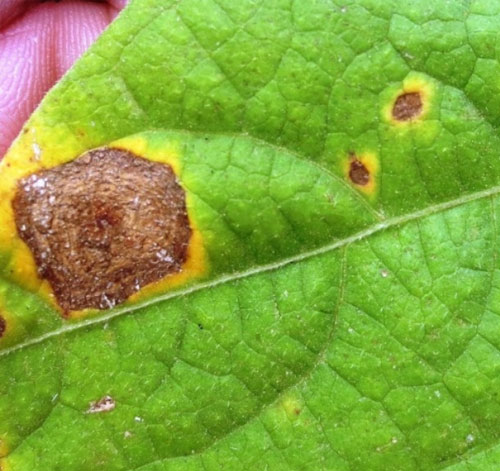
Photo 4.
Conditions conducive to the development of the disease.
The optimum temperature for spore germination is 25°C and the optimum relative humidity is 90-100%. During the growing season, rainfall and humidity influence the spread and development of the disease. If the seedlings are planted too densely, poorly ventilated, in the shade, wet or thin and weak, the infection rate becomes very high.
Control methods
- Nurseries should be established away from paulownia plantations and should be moved after the appearance of diseases. The timing of planting should be determined according to the local climate so that the early germination period does not coincide with the rainy season.
- Care should be taken to encourage vigorous seedling growth to increase disease resistance.
- The soil should be treated with 8 g of pentachloronitro-benzene per m2 or iron sulfate etc. per m2 three to five days before planting. Soak the seeds in a 0.2% solution of phenylmercury acetate for 30 minutes before planting. Spray Bordeaux mixture at 0.5-0.7% twice a month during the growing season and it is an effective control measure.
- Sphaceloma (Sphaceloma paulownia Hara).
Sphaceloma (Photo 5) paulownia is a common disease that affects paulownia seedlings and young trees. When the shoots develop brown spots with a yellow border on the young leaves and sometimes on the stems. Later, small round holes appear in the affected areas. The spots on the leaves are also joined by irregular breaks. Damaged veins on young leaves often cause leaf deformation.
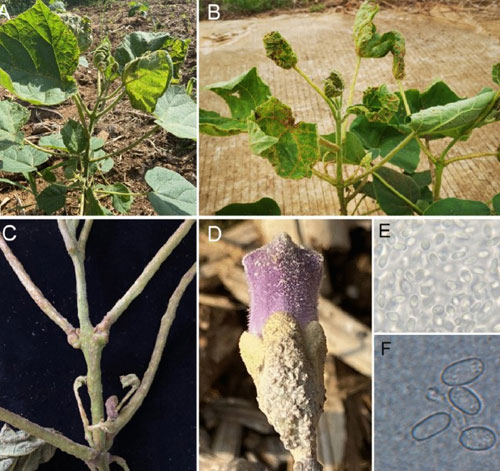
Photo 5.
Spots on leaf petioles and young stems are round or elliptical in shape. The brownish-black spots form bands and develop into crusts that cause curling, wilting and death of shoots and young leaves if infection is severe. The timing of this disease is similar to that of anthracnose. Control methods are the same as for anthracnose.
-
Drying of young plants.
Seedling desiccation (Figure 6) mainly affects young spring plantings. Its main symptoms are bud rot, desiccation, stem and leaf rot and root rot. The pathogenesis of this disease is very complex, but the main organisms responsible are Rhizoctonia solani and Fusarium species. The pathogens overwinter on plant fragments in the soil and begin to spread in early spring after a thaw. The severity of infection depends on the characteristics of the soil, the accumulation of pathogens in the soil and, perhaps most importantly, the mode of spread.
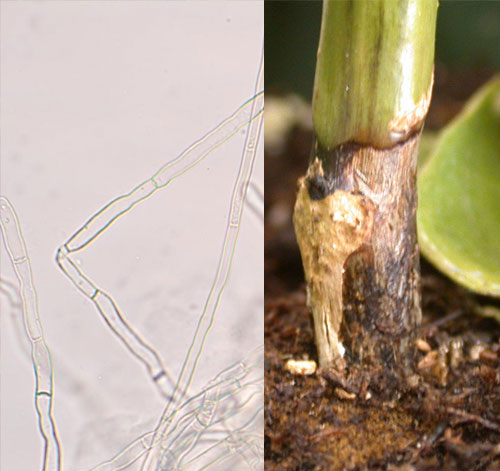
Rhizoctonia solani
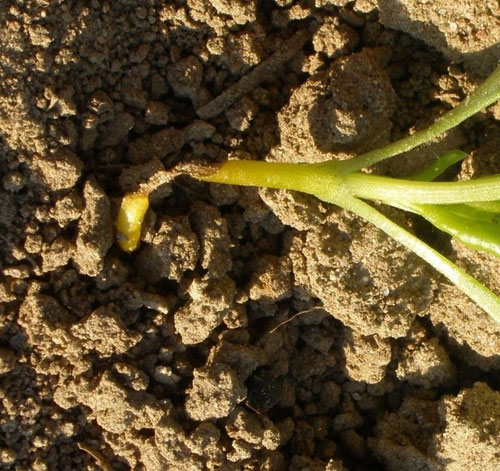
Photo. 6.
The control methods are as follows:
- The seedbed is disinfected with a 3% iron sulfate solution (FeSO4) at a rate of 4.5 kg/m2. The plantation is carried out seven days after the disinfection.
- To control infection, spray with Bordeaux mixture once every 10-15 days. In case of infestation, spray topsin with 50% methyl radical.
Other fungi that affect paulownia:
- Phyllactinia imperialis Miyabe;
- Uncinula clintonii Peck;
- Cercospora paulownia Hori;
- Mycosphaerella paulownia Shirai et Hara;
- Valsa paulownia;
- Miyabe et Hemmi;
- Septobasidium tanakae (Miyabe) Boed et Steinm.
These pathogens are not very common and do not cause significant damage. Improving agricultural practices to ensure healthy and strong tree growth can reduce the frequency and severity of diseases.
In addition, there are two species of Loranthus parasiticus that are stem parasites that cause significant damage. These are Loranthus parasiticus (Linn.) Merr. and L. yadoriki Sieb.
The major insects that damage paulownia are:
Agrotis ypsilon (Rott.), A. toxionis Butler, Euxoa segetum Schiff, Serica orientalis Matsch, Anomala corpulenta Matsch, Holotrichia diomphalia, Gryllotalpa unispina Saussure, G. africana palisot de Beauvois, Empoasca flavescens (Fabricius), Cicadalla viridis L., Cryptotothlea variegata Snellen, Psilogramma menephron Cramer, Batocera horsfieldi Hope, Megopis sinica White та Basiprionota. The extent of insect damage varies from region to region, and detailed data are being collected.



